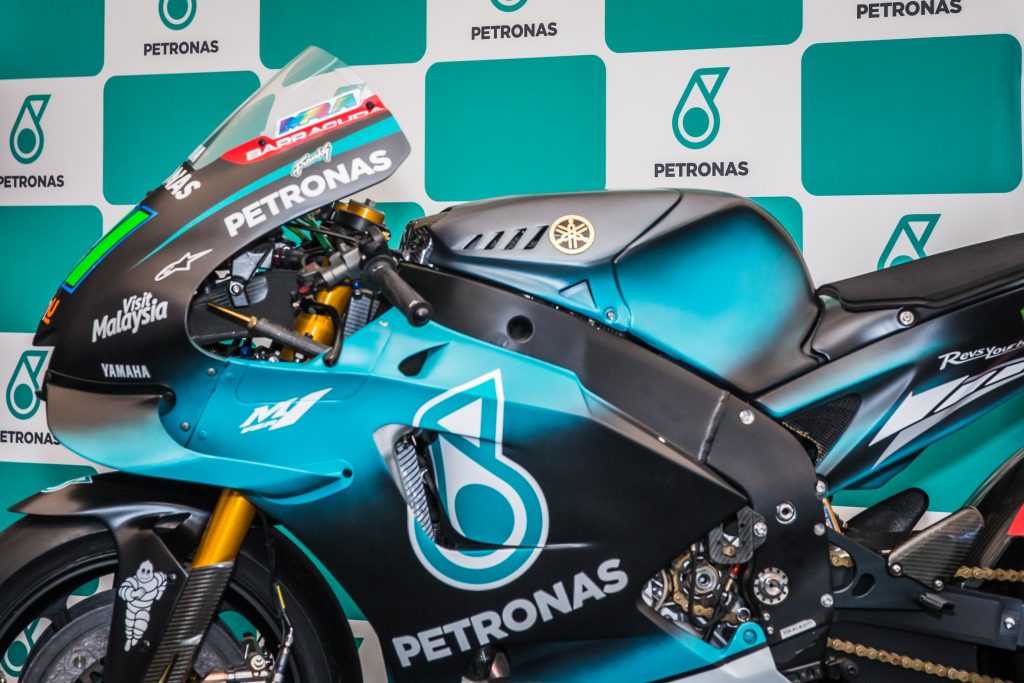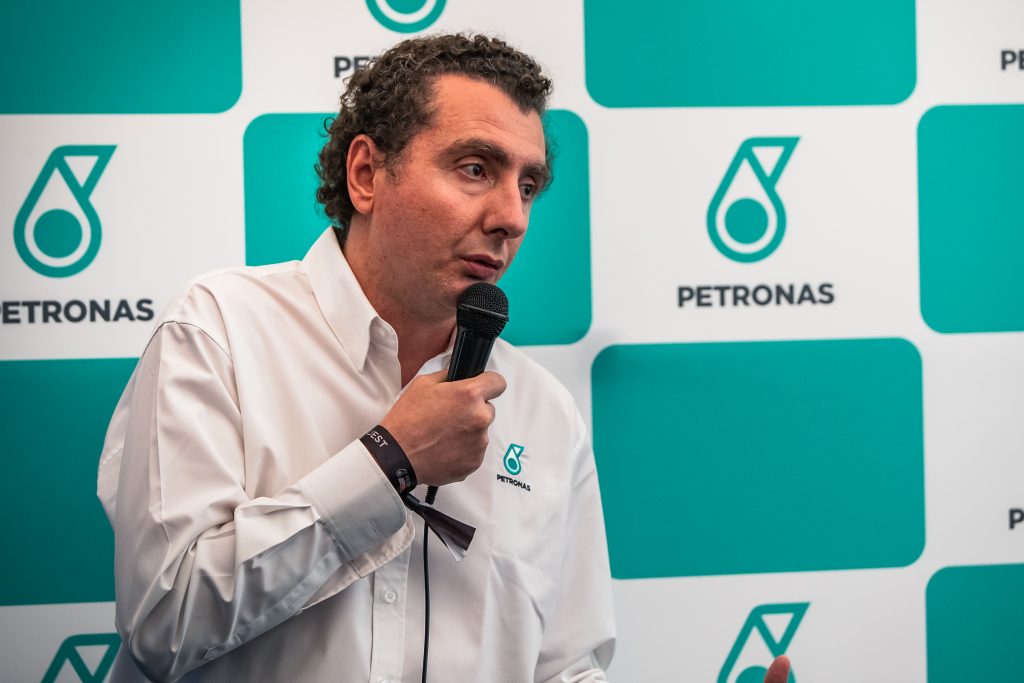“For the engines we’re using about 800 litres a year and around 500 of gearbox oil,” revealed Petronas Yamaha SRT Team Manager Wilco Zeelenberg, the Dutchman is a former grand prix racer and toasted three podium finishes at Assen himself. “We all know MotoGP engine combustion and RPM and temperatures are amazing – very high – and to make something in such a short period of time that functions so well is really impressive and we are very happy with it.”
Less than four hours after stopping his #20 race machine (loaded with Petronas Tutela gear oil and Petronas Sprinta engine oil – the latter used for the very first time) in the number one position in Parc Ferme, 20 year old French star Quartararo was part of a presentation line-up to launch the Sprinta product in front of a select gathering of international media.
Everything has moved very quickly for MotoGP’s newest team. The roll of momentum that began with Tech3 leaving the Japanese manufacturer for KTM surged forward when Sepang Racing Team aligned with the former F1 world champion’s sponsor, assumed the Aspar team grid spots, recruited Zeelenberg from the factory team and signed the unassuming Quartararo as an optimistic ‘punt’ for 2020 alongside Franco Morbidelli.

Since those hectic months in the middle and towards the end of 2018, Petronas Yamaha SRT have galloped into contention with their riders and are arguably just as competitive as the official Monster Energy squad. Rumours floated in Assen that Quartararo had been rewarded with a factory chassis on his M1 for his pace, results and consistency (just one crash in the first half of the season). Petronas has also been pushing hard.

“When we first started the project we expected it to be completed in two years,” admitted General Manager of Petronas Brand Management Department, Group Strategic Communications, Noor Afiza Mohd Yusof. “And today, less than a year, we managed to bring onboard two products – one for the gears (Petronas Tutela) at Qatar – and today Petronas Sprinta (engine oil). We are very, very happy with the performance…and for the team because we thought it might take a few years before we would come to the level we have today.”
“It has been quite an amazing journey for us because we were tasked with a tight time schedule to deliver some very important results,” commented Dr Andrea Dolfi, who is Head of Petronas R&D Fluid Technology Solutions. “We started with the Petronas Tutela gearbox oil and not because it was the easiest but it was the product that concerned us the most: the gearbox is paramount to the rider’s safety. If something breaks down then it might become stuck, broken and the rider could crash while riding at 300kmph. So it was important and a number one task: safety first, then performance. Then we started with Petronas Sprinta engine oil and this is again delivering performance but with reliability. Reliability is an important part because there is no point in going faster and having more power if you damage the engine or do not finish the race.”

Dr Dolfi explained some of the work and chemistry – as well as the challenges – that went into the completion of Petronas Sprinta oil and how the company were able to count on a very comprehensive collaboration with Yamaha; even visiting the Japanese manufacturer at their HQ in Iwata.
“The key for this success, which we are starting to enjoy right now, is the collaboration between us (Petronas) and Yamaha,” he added, while holding a vial of the Petronas Sprinta Oil. “Yamaha opened their doors and they laid bare the engine. I saw all the high tech pieces for me to understand faster the implications of our lubricants, how to make it better, more reliable at the same time deliver performance. Collaboration has been key and, of course, at the beginning we were in a tight time schedule. The next step is to move even further in terms of partnership and tackle the development for what is called ‘co-engineering.”
Back to MotoGP and Zeelenberg revealed some more interesting details about the Yamaha’s oil consumption. “We are not allowed to carry oil around the world, especially for the overseas races the engines need to be emptied and that means quite a bit of oil…and we don’t re-use it,” he said, explained the 800-litre figure. “During a race weekend we just need to fill it once and we can use the same all weekend.”

“These bikes have dry clutches so there is no material coming into the oil and that makes a big difference,” he added. “If you go really critical on very thin oils or something special it may have some implications for safety or the quality is worse. Then maybe you need to use more. But we can basically ride all weekend with it.”
Dolfi was able to ruminate on Petronas’ successful work in F1. The brand are prominent in MotoGP, and now even more so than just a sponsor (Zeelenberg: “this is very important as it brings something to the team for set-up”) and all the technical nuance from the cars and what the Italian calls “the pinnacle of automotive motorsport” is feeding into the bikes courtesy of their Fluid Technology Solutions.
“Going more into the technical detail we are still talking about a naturally aspirated type of engine,” he said of MotoGP. “In F1 we had a change of regulation and in 2014 we went from that and downsized to supercharged and which also had an impact in the way we approach fuel and engine oil. So [for MotoGP] we had a look at our old notebooks and found some secrets.”
Barrelling further and faster is also the job of one man in particular. The last word went to Quartararo – who’s debut season in MotoGP continues to surprise and delight, much like the splash that Petronas have made on the championship already with less than half a campaign in the books. “We adapted quite fast to this bike and in Qatar is where we already felt that the Yamaha was in good shape with the team,” he evaluated. “I think the comfort we have here, with all the partners, people and support of experts like Petronas, is like a family and this is really important in MotoGP.”
By Adam Wheeler @ontrackoffroad
Photos by Petronas/Polarity Photo








